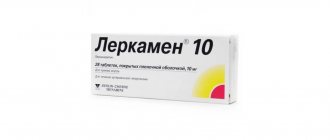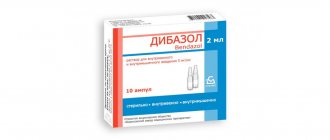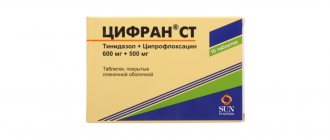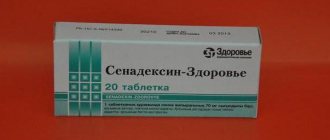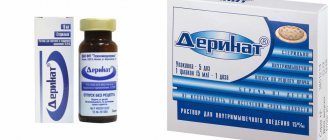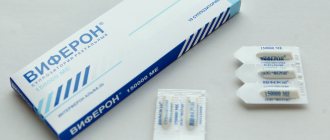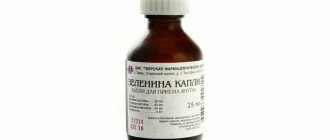Cervical osteochondrosis is a disease (mostly chronic) of the cervical spine, which is based on degeneration of the cartilage fiber that makes up the bulk of the intervertebral disc. One of the complications of this pathology is impaired cerebral circulation, which can lead to chronic hypoxia of the brain and disruption of its functions, including reflex activity. One of the drugs that is used to correct endogenous intoxication and normalize oxygen metabolism in cervical osteochondrosis is Mexidol. Despite the fact that the effectiveness of the drug in the treatment of osteochondrosis has not been confirmed by evidence-based medicine, the drug is often used for grade 3-4 disorders in combination with other drugs, which allows subjective conclusions to be drawn about stable effectiveness and a high probability of positive dynamics of the therapy.
"Mexidol" for osteochondrosis of the cervical spine
Composition and release form
Active ingredient: ethylmethylhydroxypyridine succinate – 50 mg. Excipients: sodium metabisulfite – 0.4 mg; water for injections up to 1 ml. Solution for intravenous and intramuscular administration 50 mg/ml in colorless or light-protective glass ampoules with a blue break point or a white break point and three marking rings (top - yellow, middle - white, bottom - red) 2 ml or 5 ml . 5 ampoules in a blister pack. 1 or 2 blister packs along with instructions for medical use in a cardboard pack. 4, 10 or 20 blister packs along with instructions for medical use in a box of cardboard (for hospitals).
What complications of cervical osteochondrosis are treated by Mexidol?
Osteochondrosis not only negatively affects the functional state of the spine, but also negatively affects the functioning of some internal organs (especially in cases where cervical osteochondrosis is combined with degeneration of the thoracic region): the brain, heart, and respiratory tract. For this reason, Mexidol can be prescribed to patients with osteochondrosis, both to correct blood circulation in the vessels of the brain and prevent hypoxia, and to reduce the negative consequences associated with possible complications of the underlying disease.
The drug can be prescribed to normalize blood circulation in the vessels of the brain
Secondary indications for the use of products based on ethylmethylhydroxypyridine succinate against the background of cervical and cervicothoracic osteochondrosis are:
pharmachologic effect
Antioxidant agent. Means for the correction of disorders in alcoholism, toxic and drug addiction.
Pharmacokinetics
With intramuscular administration, it is determined in the blood plasma for 4 hours after administration. The time to reach the maximum concentration Tmax is 0.45-0.5 hours. Cmax when administering a dose of 400-500 mg is 3.5-4.0 μg/ml. Mexidol quickly passes from the bloodstream into organs and tissues and is quickly eliminated from the body. The drug retention time (MRT) is 0.7-1.3 hours. The drug is excreted mainly in the urine, mainly in glucurone-conjugated form and in small quantities unchanged.
Pharmacodynamics
It has antihypoxic, membrane-protective, nootropic, anticonvulsant, anxiolytic effects, and increases the body's resistance to stress.
The drug increases the body's resistance to the effects of major damaging factors, to oxygen-dependent pathological conditions (shock, hypoxia and ischemia, cerebrovascular accident, intoxication with alcohol and antipsychotic drugs (neuroleptics)). Mexidol improves cerebral metabolism and blood supply to the brain, improves microcirculation and rheological properties of blood, and reduces platelet aggregation. Stabilizes the membrane structures of blood cells (erythrocytes and platelets) during hemolysis. It has a hypolipidemic effect, reduces the level of total cholesterol and LDL. Reduces enzymatic toxemia and endogenous intoxication in acute pancreatitis. The mechanism of action of Mexidol is due to its antihypoxic, antioxidant and membrane protective effects. It inhibits the processes of lipid peroxidation, increases the activity of superoxide dismutase, increases the lipid-protein ratio, reduces membrane viscosity, and increases its fluidity. Modulates the activity of membrane-bound enzymes (calcium-independent phosphodiesterase, adenylate cyclase, acetylcholinesterase), receptor complexes (benzodiazepine, GABA, acetylcholine), which enhances their ability to bind to ligands, helps preserve the structural and functional organization of biomembranes, transport of neurotransmitters and improve synaptic transmission.
Mexidol increases dopamine levels in the brain. Causes an increase in the compensatory activity of aerobic glycolysis and a decrease in the degree of inhibition of oxidative processes in the Krebs cycle under hypoxic conditions, with an increase in the content of ATP, creatine phosphate and activation of the energy-synthesizing functions of mitochondria, stabilization of cell membranes. Mexidol normalizes metabolic processes in the ischemic myocardium, reduces the necrosis zone, restores and improves the electrical activity and contractility of the myocardium, and also increases coronary blood flow in the ischemic zone, reduces the consequences of reperfusion syndrome in acute coronary insufficiency. Increases the antianginal activity of nitro drugs. Mexidol promotes the preservation of retinal ganglion cells and optic nerve fibers during progressive neuropathy, the causes of which are chronic ischemia and hypoxia. Improves the functional activity of the retina and optic nerve, increasing visual acuity.
To whom are drugs based on ethylmethylhydroxypyridine succinate contraindicated?
Mexidol has virtually no absolute contraindications, and all restrictions on its use are conditional. A fairly significant contraindication for such therapy is severe kidney or liver disease, since the metabolism of ethylmethylhydroxypyridine succinate occurs in hepatocytes, and its metabolites are excreted from the body by the kidneys along with urine (some of them unchanged). For patients prone to allergic reactions and with a history of allergies to drugs in this group, treatment with Mexidol is contraindicated.
Taking Mexidol is contraindicated for people with kidney disease
Important! Mexidol and its analogues are not used in official medicine in Western countries, and preparations based on ethylmethylhydroxypyridine succinate do not have a patented international name. The lack of sufficient data on the safety of Mexidol, obtained using evidence-based medicine, does not allow its use for the treatment of minor patients, pregnant and lactating women.
Indications for use of Mexidol
- acute cerebrovascular accidents;
- traumatic brain injury, consequences of traumatic brain injury;
- iscirculatory encephalopathy;
- autonomic dystonia syndrome;
- mild cognitive disorders of atherosclerotic origin;
- anxiety disorders in neurotic and neurosis-like conditions;
- acute myocardial infarction (from the first day) as part of complex therapy;
- primary open-angle glaucoma of various stages, as part of complex therapy;
- relief of withdrawal syndrome in alcoholism with a predominance of neurosis-like and vegetative-vascular disorders;
- acute intoxication with antipsychotic drugs;
- acute purulent-inflammatory processes of the abdominal cavity (acute necrotizing pancreatitis, peritonitis) as part of complex therapy.
Why do you need Mexidol for cervical osteochondrosis?
Osteochondrosis is, first of all, a degenerative pathology in which deformation of the intervertebral discs occurs (the vertebrae are compressed and crush the disc located between them). An intervertebral disc is a formation of fibrocartilaginous annular plates filled with a gelatinous jelly-like core and surrounded by a connective tissue membrane. With osteochondrosis, compression of two adjacent vertebrae occurs, which puts pressure on the disc and causes displacement of the pulp, which begins to bulge and protrude through the fibrous membrane. Such displacements are called hernias and protrusions.
If you want to learn in more detail how protrusion differs from herniated intervertebral discs, and also consider the causes of manifestations, diagnosis and treatment methods, you can read an article about this on our portal.
One of the characteristic symptoms of osteochondrosis is the formation of protrusions and hernias in the spine
Hernias and protrusions can cause not only compression of the spinal endings, but also compression of the blood vessels through which blood enriched with minerals and oxygen enters the brain cells. Muscle spasms and swelling of paravertebral soft tissues can also interfere with the flow of lymph and blood. Clinically, circulatory disorders in cervical osteochondrosis of the 3rd degree are manifested by chronic headaches, instability of blood pressure, visual and auditory dysfunction.
Circulatory disorders caused by osteochondrosis are manifested by painful headaches
Mexidol allows not only to establish microcirculation of fluids in blood and lymphatic vessels, but also to improve the neurotrophic parameters of tissues, as well as reduce the degree of endogenous intoxication caused by the destruction of intervertebral disc components.
The clinically significant effect of treatment with the drug is manifested by the following result:
- relief or significant reduction in the intensity of cervicogenic headaches and dizziness;
- elimination of noise and squeaking in the ears;
- restoration of impaired visual function (disappearance of spots, flickering, ripples before the eyes);
- the severity of neurological disorders (paresis and paresthesia) decreases.
After taking the drug, limbs become less numb and the severity of neurological disorders decreases
Note! The main therapeutic effect of using Mexidol as part of a complex treatment of dystrophy and degeneration of intervertebral discs in the cervical spine is to improve blood circulation and prevent cerebral hypoxia.
Mexidol dosage
IM or IV (stream or drip). When administered by infusion, the drug should be diluted in 0.9% sodium chloride solution.
Mexidol® is administered slowly over 5–7 minutes in a stream, and dropwise at a rate of 40–60 drops per minute. The maximum daily dose should not exceed 1200 mg.
For acute cerebrovascular accidents, Mexidol® is used in the first 10–14 days - 200–500 mg IV drip 2–4 times a day, then 200–250 mg IM 2–3 times a day for 2 weeks .
For traumatic brain injury and the consequences of traumatic brain injuries, Mexidol® is used for 10-15 days intravenously at a dose of 200–500 mg 2–4 times a day.
For dyscirculatory encephalopathy in the decompensation phase, Mexidol® should be prescribed intravenously in a stream or drip at a dose of 200–500 mg 1–2 times a day for 14 days. Then IM 100–250 mg/day over the next 2 weeks.
For a course of prophylaxis of discirculatory encephalopathy, the drug is administered intramuscularly at a dose of 200–250 mg 2 times a day for 10–14 days.
For mild cognitive impairment in elderly patients and anxiety disorders, the drug is used intramuscularly at a daily dose of 100–300 mg/day for 14–30 days.
In case of acute myocardial infarction, as part of complex therapy, Mexidol® is administered intravenously or intramuscularly for 14 days, against the background of traditional therapy for myocardial infarction, including nitrates, beta-blockers, angiotensin-converting enzyme (ACE) inhibitors, thrombolytics, anticoagulant and antiplatelet agents, as well as symptomatic means according to indications.
In the first 5 days, to achieve maximum effect, it is advisable to administer the drug intravenously; in the next 9 days, Mexidol® can be administered intramuscularly.
Intravenous administration of the drug is carried out by drip infusion, slowly (to avoid side effects) in a 0.9% sodium chloride solution or 5% dextrose (glucose) solution in a volume of 100–150 ml for 30–90 minutes. If necessary, a slow jet injection of the drug, lasting at least 5 minutes, is possible.
The drug is administered (intravenous or intramuscular) 3 times a day, every 8 hours. The daily therapeutic dose is 6-9 mg/kg body weight per day, a single dose is 2-3 mg/kg body weight. The maximum daily dose should not exceed 800 mg, single dose - 250 mg.
For open-angle glaucoma of various stages, as part of complex therapy, Mexidol® is administered intramuscularly at 100–300 mg/day, 1–3 times a day for 14 days.
For alcohol withdrawal syndrome, Mexidol® is administered in a dose of 200–500 mg intravenously or intramuscularly 2–3 times a day for 5–7 days.
In case of acute intoxication with antipsychotic drugs, the drug is administered intravenously at a dose of 200-500 mg/day for 7-14 days. In acute purulent-inflammatory processes of the abdominal cavity (acute necrotizing pancreatitis, peritonitis), the drug is prescribed on the first day both in the preoperative and postoperative periods. The administered doses depend on the form and severity of the disease, the prevalence of the process, and variants of the clinical course. The drug should be discontinued gradually only after a stable positive clinical and laboratory effect.
For acute edematous (interstitial) pancreatitis, Mexidol® is prescribed 200–500 mg 3 times a day, intravenously (in 0.9% sodium chloride solution) and intramuscularly. Mild severity of necrotizing pancreatitis - 100-200 mg 3 times a day intravenously (in 0.9% sodium chloride solution) and intramuscularly. Moderate severity - 200 mg 3 times a day intravenously (in 0.9% sodium chloride solution). Severe course - in a pulse dosage of 800 mg on the first day with a double dose regimen; then 200–500 mg 2 times a day with a gradual reduction in the daily dose. Extremely severe course - at an initial dosage of 800 mg/day until the manifestations of pancreatogenic shock are persistently relieved, after stabilization of the condition, 300-500 mg 2 times a day intravenously (in 0.9% sodium chloride solution) with a gradual decrease in the daily dosage.
Structural and pharmacological equivalents
Mexidol has several pharmaceutical equivalents (structural analogs with the same active ingredient). Among them:
- "Neurocard";
- Astrox;
The drug "Astrox" - "Mexico";
- "Mexidant";
- "Mexiprim."
The drug "Mexiprim"
If an allergy to ethylmethylhydroxypyridine succinate is detected, the doctor can select drugs with similar therapeutic effects and pharmacological properties. Some of them are shown in the table below.
Table. Analogues of Mexidol with a similar effect
| A drug | How it works |
| "Milgamma" ("Kombilipen", "Compligam V", "Vitaxon") | Replenishes the deficiency of vitamins necessary for the normal functioning of the nervous system and brain, normalizes metabolism in tissues, and has a moderate analgesic and neuroprotective effect. |
| "Actovegin" | Belongs to the group of antioxidants and antihypoxants, improves oxygen transport and prevents tissue hypoxia. The drug also improves tissue trophism and corrects microcirculation of lymphatic fluid and blood. |
| "Elkar" | Replenishes the lack of levocarnitine, stimulates osteochondral metabolism. |
"Elkar": dosage and method of administration
Side effects
The drug is usually well accepted by the body and does not produce side effects. In rare cases, patients experience the following phenomena:
- vomit;
- disruption of the digestive tract;
- drying of the mucous membranes of the oral cavity;
- allergic reaction.
- the drug is widely used in ophthalmology for preventive purposes;
- Levomycetin - analogues;
- .
Impact on the body
Mexidol is a Russian drug sold in tablet and injection form.
The active ingredient is ethylmethylhydroxypyridine succinate. This compound has a variety of positive effects on the human body:
- suppresses the activity of free radicals;
- prevents platelet aggregation and blood clot formation;
- lowers the concentration of bad cholesterol in the blood;
- normalizes the spread of nerve impulses through tissues;
- stimulates lipid metabolism;
- has a positive effect on the condition of cell membranes;
- inhibits lipid oxidation;
- improves metabolic reactions in cells.
Which is better – Cavinton or Mexidol?
Cavinton and Mexidol are analogues only in terms of their effect on the body, but not in terms of their chemical composition. The active component of Cavinton is vinpocetine.
This substance increases the strength of blood vessels, normalizes blood circulation in the brain, makes brain tissue more resistant to oxygen starvation, and improves glucose metabolism.
It should be noted that the original drug has a wider spectrum of action than its analogue. Mexidol not only normalizes blood circulation, but also has an antioxidant effect.
Cavinton is sold in tablet and injection form, and also in the form of soluble tablets. The injection solution is intended exclusively for intravenous administration, since the active substance is destroyed in muscle tissue.
Oral tablets contain 5 or 10 mg of active ingredient. Soluble orange tablets are prescribed to patients with impaired swallowing function.
Cavinton has more side effects than Mexidol, but the effectiveness of the analog is slightly higher than the original drug.
Both medications can be used in combination, as they have different chemical compositions.
Doctors often recommend that patients take medications together: Cavinton primarily normalizes blood circulation and the condition of blood vessels, while Mexidol has a greater effect on cellular metabolism.
The price difference between the drugs is insignificant. A course of treatment with the tablet form of Mexidol costs 850–1000 rubles. For a course of Cavinton in tablets you will have to pay 900 rubles.
Mexidol analogues are cheaper (list with prices)
In pharmacies you can find many foreign and domestic cheap analogs of Mexidol, sold both in tablets and ampoules.
Popular analogues according to composition and principle of effect on the body are listed below, indicating the average price:
- Mexicor – 230 rubles;
- Meksifin – 240 rubles;
- Mexiprim - 355 rubles;
- Astrox – 310 rubles;
- Neurox – 355 rubles;
- Cerecard – 240 rubles;
- Medomexi – 220 rubles.
There are also drugs that have different chemical compositions with Mexidol, but the same principle of action on the body.
Such cheap analogues of Mexidol, produced in tablets and ampoules, include:
- Actovegin – 1020 rubles;
- Glycine – 95 rubles;
- Nootropil – 280 rubles;
- Instenon – 265 rubles;
- Cortexin – 920 rubles;
- Cavinton – 360 rubles;
- Mildronate – 445 rubles.
